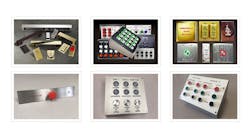The door hinges on metal perimeter doors in commercial and industrial buildings practically all look the same from the outside. However, many have ordinary hinges whose hinge pins are easily removed from the outside, allowing the hinge side of the door to be opened from the outside. Other doors have security hinges whose hinge pins cannot be removed, and some doors have special security hinges that keep the door from being opened from the outside even if the hinge pins are removed.
Q: What kind of door do we need to keep our equipment secure? Recently someone entered one of our equipment rooms from the outside by removing the hinge pins from the door hinges. We suspect that it was worker who came back after hours to retrieve a toolbox, but some telephones stored in the room are now also missing.
A: Ordinary hinges are a common building perimeter door vulnerability that is found during many facility security assessments. There are two kinds of security hinges for commercial doors that address this problem.
So that the door can be opened outward, the hinges on electrical and telecom room building perimeter doors are located on the outside. This often means that anyone with a small Phillips screwdriver and a hammer can remove the hinges easily and take the door off, regardless of the strength of the door and its locking hardware. Two types of security door hinges keep the door in place:
- Security set-screw hinge
- Security stud butt hinge
These hinges are shown in the Figure 1 and Figure 2 illustrations.
Secure Hinge Designs
A security set-screw hinge (see Figure 1) looks the same from the outside as a non-secure hinge. The difference is the set-screw that cannot be accessed from the outside, which screws into the hinge pin and prevents the pin from being removed when the door is closed.
A security stud hinge (see Figure 2) also looks the same from the outside as a non-secure hinge. The difference is that the hinge contains thick metal studs on one side of the hinge that move into corresponding holes on the other side of the hinge when the door closes.
The hinged side of the door cannot be moved even with the hinge pins removed, because the studs prevent the hinge leaves from being slid apart.
A similar design is used (not illustrated) for prison doors and other very high security facilities, where the studs project from the back of the hinge into the door and frame, and can withstand around 200 foot pounds of pressure in a ram test, which would normally shear the hinge installation screws but cannot shear the studs.
Monitoring Equipment Room Doors
Doors to critical equipment rooms, whether the open to the building interior or exterior, should be access-controlled doors that alarm when held open too long or when access is denied (to alert security to a possible attempt at unauthorized entry). They should be monitored visually by video that is displayed to a live operator (or alternatively has an image or video clip sent to a responding individual’s computer or phone).
Network and telephone system equipment often share a room with electrical and other types of equipment. Access is usually granted to multiple insiders and outsiders, and there are valid reasons when work is being for the doors to be propped open, and in such cases the rooms are sometimes left unoccupied long enough for unauthorized access to occur as well. Thus a means should be established to detect when a door is propped open more than momentarily, and to visually—whether remotely or in person—visually monitor the room when the door is kept open.
Correcting Non-Secure Hinges
For facilities where there has been no known security inspection to determine if all perimeter doors have security hinged installed, such an inspection should be made a high priority. Door hinges with setscrew or security stud features cost only five to ten dollars more than similar non-security hinges. Commercial door hinges are usually in the $100 to $200 price range, a fraction of the cost of the equipment and systems being protected. Replacing non-secure hinges on critical equipment room doors is a low-cost quick-win security improvement.
About the Author:
Write to Ray about this column at [email protected]. Ray Bernard, PSP, CHS-III is the principal consultant for Ray Bernard Consulting Services (RBCS), a firm that provides security consulting services for public and private facilities. For more information about Ray Bernard and RBCS go to www.go-rbcs.com or call 949-831-6788. Ray is also a member of the Content Expert Faculty of the Security Executive Council (www.SecurityExecutiveCouncil.com). Follow Ray on Twitter: @RayBernardRBCS.


